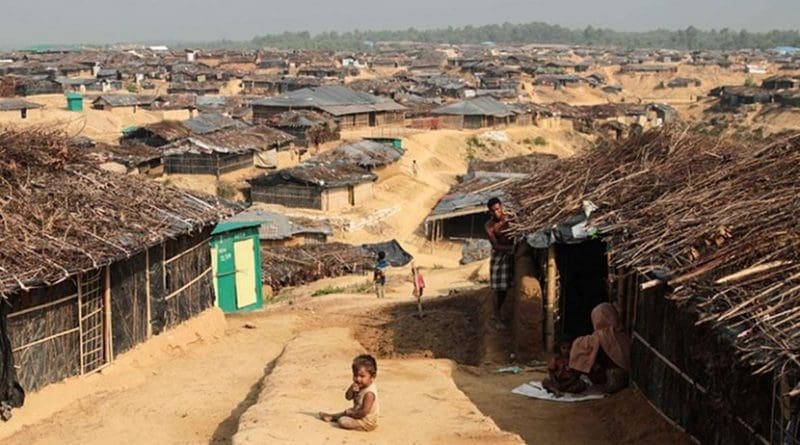Rohingya Crisis: Why ‘Local Integration’ Is The Wrong Policy – OpEd
The massive influx of forcibly displaced Rohingya refugees since August 2017 has added a major concern for the hosting Bangladesh and the United Nations High Commissioner of Refugees (UNHCR). Four years have passed but a single refugee has yet to be repatriated to Myanmar. At present, the number of Rohingya refugees is approximately 1.2 million- most of them are staying in the overcrowded camps in the Southern Cox’s Bazar region of Bangladesh.
To ease pressure from the camps and to maintain law and order, Bangladesh has initiated a plan to relocate some 100,000 Rohingya refugees to Bhashan Char, situated in the district of Noakhali- a temporary relocation plan until the repatriation resumes. In the meantime, the World Bank proposes ‘local integration’- one of the three solutions uttered by UNHCR- of Rohingya refugees in the global Refugee Policy Review Framework promising financial assistance. Does the proposal make any sense for a country that is not a signatory of the 1951 Geneva convention, massively burdened with overpopulation and in a crucial position of its development transition? And why ‘local integration’ is a wrong policy persuasion?
First, The Rohingya FDMNs are not interested in getting the citizenship of Bangladesh. In response to the World Bank’s proposal for integrating Rohingyas into Bangladesh, the Arakan Rohingya Society for Peace and Human Rights (ARSPHR) stated that their only goal is to return to their “native motherland with dignity, safety, and security”. ARSPHR Chairman Mohib Ullah said the World Bank recommendation will only produce more glitches for the Rohingya that temporarily live here.
Second, the ‘local integration’ plan will inspire the Tatmadaw creating more havoc and the rest of the Rohingyas in Myanmar will be inclined to cross the border and taking refuge in Bangladesh. The World Bank proposal is directly or indirectly supporting the intention of the government of Myanmar, which forcibly pushed them out from Rakhine and committed genocide against them. The failure to address the genocide as a “genocide” as well as integrating them locally will make the crisis a complex one.
Third, “Local integration” has an obvious demographic conflict between the hosting and asylum seekers. The people of Bangladesh have been showing exemplary compassion to the Arakan Muslims, however, local integration will fade away the sympathy and the ‘we versus them’ conflict will be the decisive consequence. Besides, integrating a massive number of approximately 1.2 million Rohingyas will change the demographic shift of the strategically important part of Bangladesh.
Fourth, Bangladesh is not a signatory of the 1951 Geneva convention on refugees. However, from the humanitarian ground, it has done its part. Integrating the Rohingya FDMNs will create more and more socio-economic and environmental threats for the country. Finally, “local integration” has both traditional and non-traditional security concerns for the nation. It is already reported that a number of Rohingya FDMNs are actively engaged with arms and drug trafficking; Nearly 92 percent of Yaba tablets are smuggled by Rohingya and over 96 percent of Yaba tablets arrive in Bangladesh via the Taknaf route. Besides, it has other security implications including border security, radicalization, smuggling, human trafficking and other criminal activities.
Bangladesh is continuously supporting the forcibly displaced Myanmar Nationals (FDMNs), however, the international community seems to leave the onus solely on Bangladesh bypassing their responsibility. The proposal of the World Bank is a surprising and shocking ‘solution’ to the Rohingya crisis through providing citizenship of Bangladesh. Bangladesh as well as the UNHCR believe that the only plausible solution to the Rohingya crisis is repatriation because locally integrating over 1.2 million is undoubtedly an impracticable policy persuasion. Third country resettlement could be partially an alternative for a viable solution under the R2P framework but it is not the only solution.
After concluding the four-day visit of UN high officials from May 30-June 02, Gillian Triggs rightly asserted during the meeting with the Foreign Minister of Bangladesh, “This [Third country resettlement] can be done for very vulnerable people and very small groups. But repatriation is the ultimate solution.” The UN, World Bank, or other international community should seek a substantive roadmap for Rohingya repatriation rather than local integration.
*Shaikh Abdur Rahman is currently working at the Central Foundation for International and Strategic Studies (CFISS) based in Dhaka. He holds a Master of Social Science degree in International Relations from the University of Rajshahi, Bangladesh. He can be reached at [email protected]

